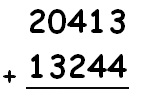Exploding Dots
3.7 Wild Explorations
Here are some “big question” investigations you might want to explore, or just think about. Have fun!
| EXPLORATION 1: THERE IS NOTHING SPECIAL ABOUT BASE TEN FOR ADDITION
Here is an addition problem in a \(1 \leftarrow 5\) machine. (That is, it is a problem in base five.) This is not a \(1 \leftarrow 10\) machine addition.
a) What is the \(1 \leftarrow 5\) machine answer? b) What number has code \(20413\) in a \(1 \leftarrow 5\) machine? What number has code \(13244\) in a \(1 \leftarrow 5\) machine? What is the sum of those two numbers and what is the code for that sum in a \(1 \leftarrow 5\) machine?
[Here are the answers so that you can check your clever thinking. The sum, as a \(1 \leftarrow 5\) machine problem, is \(20413+13244 = 3|3|6|5|7 = 3|4|1|5|7 = 3|4|2|0|7 = 3|4|2|1|2 = 34212\). In a \(1 \leftarrow 5\) machine, \(20413\) is two \(625\)s, four \(25\)s, one \(5\), and three \(1\)s, and so is the number \(1358\) in base ten; \(13244\) is the number \(1074\) in base ten; and \(34212\) is the number \(2432\) in base ten. We have just worked out \(1358 + 1074 = 2432\).] |
| EXPLORATION 2: THERE IS NOTHING SPECIAL ABOUT BASE TEN FOR MULTIPLICATION
Let’s work with a \(1 \leftarrow 3\) machine.
a) Find \(111 \times 3\) as a base three problem. Also, what are \(1202 \times 3\) and \(2002 \times 3\)? Can you explain what you notice?
Let’s now work with a \(1 \leftarrow 4\) machine.
b) What is \(133 \times 4\) as a base four problem? What is \(2011 \times 4\)? What is \(22 \times 4\)? Can you explain what you notice?
In general, if we are working with a \(1 \leftarrow b\) machine, can you explain why multiplying a number in base \(b\) by \(b\) returns the original number with a zero tacked on to its right? |
Resources
Books
Take your understanding to the next level with easy to understand books by James Tanton.
BROWSE BOOKS![]()
Guides & Solutions
Dive deeper into key topics through detailed, easy to follow guides and solution sets.
BROWSE GUIDES![]()
Donations
Consider supporting G'Day Math! with a donation, of any amount.
Your support is so much appreciated and enables the continued creation of great course content. Thanks!
Ready to Help?
Donations can be made via PayPal and major credit cards. A PayPal account is not required. Many thanks!
DONATE![]()



